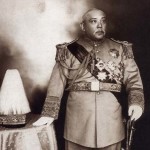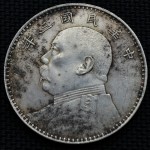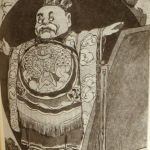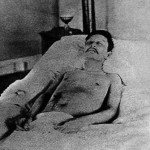
If the failure of the first Chinese republic can be attributed to one man, it is Yuan Shikai. Arguably the Qing dynasty’s most successful military commander, Shikai’s command of the modernised New Army helped bring about the end of the Qing. In February 1912 he forced the abdication of Puyi, the last emperor, in return for the presidency of the new republic. Shikai was no republican or democrat, however; he simply viewed the presidency as a stepping stone to the imperial throne. As president, Shikai’s actions sabotaged Chinese republicanism and disempowered democratic institutions before either could consolidate or mature. He meekly submitted to the demands of Japanese imperialists, ceding control of Manchuria and Shandong. His last significant action was an attempt to revive the imperial throne and place himself upon it. This produced a storm of protest and the breakaway of several provinces, forcing Shikai to abandon the restoration of the monarchy in March 1916. When he died three months later, China had already begun to fragment into a jigsaw of regional leaders, factions and private armies.
Yuan Shikai was born to a middle-class Manchu family in Henan province, central China. He was given a traditional Confucian education but proved an erratic student and a troublesome youth, preferring outdoor activities like hunting, horse-riding and martial arts. Shikai entered the army at a young age and was soon posted to Korea, where he served as an aide to the powerful general Li Hongzhang. Shikai may have been a poor scholar but he proved skilled at leadership; he was so adept at command that by 1884 he led three army divisions, despite only being in his mid-20s. The following year Shikai, despite having no political or diplomatic experience, was appointed as China’s top official in Korea. At the time the Korean peninsula was a hotbed of competing interests – Chinese, Japanese, Russian, British as well as native Korean – and this gave Yuan valuable experience in politics, negotiation and manipulation. He was recalled from Korea in 1894 and returned to Beijing. Shikai became a favourite of Dowager Empress Cixi (Wade-Giles: Tzu-hsi), who in late 1895 placed him in charge of the first New Army.

Over the next few years, Yuan Shikai continued to amass personal influence, both from the loyalty of his own troops and the support of Qing royalty and conservatives. Shikai’s armies – well-trained and disciplined in a nation where much of the military was antiquated, disorganised and largely useless – proved an effective tool for reinforcing Qing rule and protecting Beijing. In 1898 Shikai supported the Dowager Empress with the suppression of the Hundred Days’ Reforms. During the Boxer Rebellion, however, he adopted a more cautious and pragmatic approach; not wanting to risk his forces in a disastrous campaign against Eight Nation troops, Shikai ignored Cixi’s declaration of war against the foreign powers. After the Boxer Uprising, he was appointed the governor of Zhili and given several other ministerial or official roles. These government positions, along with his command of the powerful Beiyang armies, made him the most significant individual in China; his power even exceeded that of the now docile Cixi. When the Xinhai Revolution erupted in October 1911 all eyes were on Yuan Shikai and how he would turn. Would he use the military to crush the revolution and restore Qing authority – or would he side with the nationalists and topple the emperor?

At first, it seemed the general would back the Qing. In early November Shikai accepted the prime ministership and mobilised his forces; after forming a government and securing Beijing, he marched New Army regiments into Hubei province, recapturing cities that had fallen to the revolutionaries. But the revolutionaries, aware of Shikai’s changeable politics, were also negotiating with him. By the time Sun Yixian (Sun Yat-sen) was elected president of the new republican government (December 29th 1911) he had already agreed to resign the presidency in favour of Shikai, provided the general bring about the removal of the Qing. By this stage, the Qing, led by the emperor’s regent, Dowager Empress Longyu, had promised sweeping political reforms and the implementation of a constitutional monarchy – but this was all to no avail. In late January 1912 Beiyang Army officers demanded the emperor’s abdication, almost certainly at Shikai’s instruction. After a fortnight of negotiations over formalities and niceties – such as the emperor’s protection and residences – the instrument of abdication was signed on February 12th. The following day Yuan Shikai announced his support for the republic; on February 15th he was declared president.
“In the early days of the Republic, Yuan Shikai was regarded by many students as a person more capable of bringing about a strong and unified China than Sun Yixian, and more likely to give the country a stable government. A January 1912 Monthly editorial held that it was safe to entrust him with the ‘constructive work’ of ‘unifying the nation into one homogenous whole’.”
Weili Ye
Yuan had become the head of a republican government – but he was no Republican. Through 1912 Shikai filled his cabinet with acolytes and made executive decisions without consultation; he also showed contempt for the representative National Assembly, which had moved from Nanjing to Beijing as part of the transition of power. A tug of war emerged between the president and the newly formed Guomindang, which had become the largest party in both houses of the National Assembly. Shikai’s most outspoken critic was the Guomindang’s parliamentary leader, Song Jiaoren, whose public speeches urged that limitations be placed on the president’s executive power. In March 1913 Song Jiaoren was fatally wounded by a gunman in Shanghai; available evidence suggested the assassin was acting on behalf of members of Shikai’s cabinet. In July, Sun Yixian and Guomindang forces launched a ‘second revolution’ to unseat Shikai, but the general’s military soon crushed this uprising. Through manipulation and coercion, Yuan Shikai had the Guomindang declared an illegal organisation (November 1913), then moved to disband the National Assembly altogether (January 1914). The following year Yuan accepted a humiliating ultimatum, the Twenty One Demands, from the aggressive Japanese; this further weakened his credibility and popularity as a leader.

In December 1915 Yuan moved to revive Confucianism and reinstate the imperial monarchy, anointing himself as the Hongxian emperor. He justified this by suggesting the republic had failed and that a truly unified China was only possible under an autocratic monarchy. But the restoration of the Qing monarchy produced criticism, hostility and protest across China. Shikai was condemned by the press, abandoned by advisors and supporters; even his once-loyal armies showed strong signs of opposition. The restoration was the opposed by powerful provincial leaders and warlords, several of whom seceded or rebelled in the spring of 1915. Beset by opposition and delays, Shikai was forced to postpone his coronation at least three times. He eventually abandoned the restoration of the monarchy in late March. When Yuan Shikai died in June 1916 he left behind a divided nation, a critically weak government and no obvious political successor, heralding the emergence of the Warlord Era.

1. Yuan Shikai was a Qing soldier and military commander. He served as commander of the New Army and the first president of the Chinese republic, from February 1912 until his death in 1916.
2. Shikai was a career soldier who oversaw the modernisation of the Beiyang army and enjoyed the loyalty of his officers and soldiers. Seemingly a political conservative, Shikai became a favourite of Dowager Empress Cixi.
3. By the outbreak of the 1911 Revolution, Shikai had become China’s most powerful military commander. This made him a pivotal figure in the revolution and he was courted by both Qing conservatives and the republican revolutionaries.
4. Shikai sided with the Qing initially but in February 1912 he changed sides in return for the presidency of the new republic, forcing the abdication of the infant emperor Puyi.
5. Shikai’s presidency was a failure. He attempted to increase his own power, overrode then dissolved the National Assembly and probably orchestrated the assassination of Song Jiaoren. In 1915-16 Shikai attempted to restore the Qing monarchy and install himself as emperor. Not only did this fail, it caused considerable opposition within China, contributing to the unrest and division of the Warlord era (1916-1928).
© Alpha History 2018. Content on this page may not be republished or distributed without permission. For more information please refer to our Terms of Use.
This page was written by Glenn Kucha and Jennifer Llewellyn. To reference this page, use the following citation:
G. Kucha & J. Llewellyn, “Yuan Shikai“, Alpha History, accessed [today’s date], https://alphahistory.com/chineserevolution/yuan-shikai/.
This website uses pinyin romanisations of Chinese words and names. Please refer to this page for more information.
